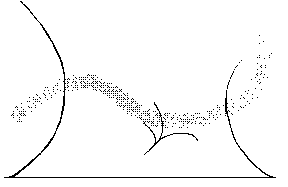This is an EL (Earth Language) experimental page to enjoy
the image of a haiku/short poem originally in English/Japanese.
When you can't see the Japanese parts,
please don't mind and just skip those parts.
地球語の文字や文字絵を用いて詩的表現や翻訳を試みる実験のページです。
Last month, my childhood friend, M. sent some series from the haiku coterie magazine "Nagisa,"
which she is joining in. Through a note there, I knew that its web site was also opened recently.
So, for this time, congratulating their web site starting,
I'd like to introduce the new web site owner's haiku here.
The author is Mr. Kitano Akihiro (Hyogo, Japan); and the haiku is from Nagisa #218 (in Japanese only).
Early spring weather in San Francisco is instable with hot sunlight or cold wind/rain.
Sometimes we see the sight like this haiku in this town, too.
A tree branch that will never bloom any more starts to run on a street like alive with its will.
I felt sympaty with the author's sentiment on the dead branch.
若者の俳句が続いたので、次は年配の方からと考えていましたら、
小学校以来の友達Mちゃんから彼女の参加している俳句同人誌『なぎさ』が届きました。
『なぎさ』にはウェブサイトもできたとあり、さっそく拝見、そして 『なぎさ』第218号(平成17年)から
今回は、このサイト・オーナーの北野晶裕さん(兵庫県)の俳句を紹介させていただくことにしました。
サンフランシスコの早春は、夏のような暑い日もあるかとおもえば、
風や雨で荒れる寒い日もあり、不安定です。
そんなこの街でも、ときにこの俳句のような瞬間に出合います。
意志をもつかのように道を走り出す、もう花を咲かせることもない枯枝と
一体になってる作者の気持ちに、共感する自分をみつけました。
 Original Japanese by Kitano Akihiro:
Original Japanese by Kitano Akihiro:



 (in the pictograph){
(in the pictograph){ preposition mark,
preposition mark,  front} : in front of (~の前の/に/で)
front} : in front of (~の前の/に/で) back,
back, pronoun} (this
sign points the center of the chest by the thumb):
pronoun} (this
sign points the center of the chest by the thumb): eye,
eye,  denied,
denied, life}: death,
dead (死んだ)
life}: death,
dead (死んだ) {
{ ,
, plant} (a branched shape:
a picture-like fundamental character): branch (枝)
plant} (a branched shape:
a picture-like fundamental character): branch (枝) (dead branch) is the subject of this sentence, locating not at the head,
so
(dead branch) is the subject of this sentence, locating not at the head,
so  (the subject identification
mark as the single form) must formally be in front of these symbols, but
since this is haiku; also the structure is very simple, I omitted the mark.
(the subject identification
mark as the single form) must formally be in front of these symbols, but
since this is haiku; also the structure is very simple, I omitted the mark.
 {
{ event,
event,  open}: beginning
(開始)
open}: beginning
(開始)